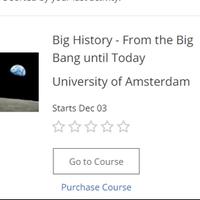1.1 Video: How can we summarize 13.8 billion years in one brief course
Hello and welcome to this big history course. My name is Esther Quaedackers and I will be your main instructor. I will not teach this course alone though. Some of the most prominent astronomers, physicists, geologist, biologist, paleontologist, neuroscientist, historians, sociologists, economist and information scientists from the University of Amsterdam and beyond will join me, and together we will give you an integrated overview of all of history from the Big Bang up until life as we know it today. But before we will start giving you such an overview I will briefly like to reflect on that task. Because how do you summarize 13.8 billion years in one brief course? Obviously, it is impossible to describe everything. That would take a lot longer than 13.8 billion years. So you have to focus on some things, while leaving most things out. And this raises a very fundamental question: how do you decide what you focus on and what you leave out? There are many ways to answer this question, and I want to encourage you to develop your own personal answer during this course. But in order to do so, it might be useful to learn a bit more about how big historians around the world are dealing with this question first. Some big historians approach big history as a story. These big historians, who are often based in the humanities departments, focus on things that intuitively feel most important, for instance things that raise a sense of wonder, are awe inspiring or thought-provoking, and fuse these things together into a an appealing narrative. The end result of this approach is a story about our past that is in some way similar to older creation stories such as Dreamtime tales, the Mayan Popol Vuh or Genesis. A big history story is similar to these other stories in a sense that it reflects the questions, the fears and the dreams that are most important to the people who create and share the story. But there's also a big difference between big history and older creation stories. In contrast to these older stories, big history is firmly based on the latest scientific and scholarly ideas. So even if in this approach there's quite a lot of room for subjective and even artistic ways to compile the story, there's no room to temper with the scientific and scholarly ideas that from the basic building blocks of the story. Other big historians, quite often those based in science departments, use a different approach. They construct big history theories. They focus on the underlying patterns in big history and on the things that might be able to support or refute ideas about these patterns, much like for instance, Big Bang cosmology, plate tectonics and the theory of evolution do. Like cosmologists, geologists, and evolutionary biologists, these bigger stories do not try to describe every star, rock or living being. Instead, they try to describe the general mechanism that can lead to the emergence of large numbers and varieties of stars, rocks, living beings, and even human societies. A third approach, first developed by my colleague Jonathan Markley and me, falls somewhere in between the big history stories and the big history theories. It consists of writing little big histories, in which you take a relatively small subject and link that to aspects of all major phases in big history ,in order to generate some new questions and ideas about the subject. This approach is bit more structured and systematic than the big history story approach, and a bit more personal and concrete than a big history theory approach, and is therefore ideal for smaller research projects such as Ph.D. projects or student assignments. These three approaches will be represented in this course in different ways. I will open all modules, except the first and the last one, with an overview of a specific phase in big history, and I will base that overview on what is currently the most prominent big history theory. Next, renowned guest lectures will build on this overview by adding details they, our university, and our society feel are most important, and together they will tell an inspiring creation story, naturally one based on the latest scientific and scholarly ideas. I will conclude all modules, again except for the first and the last one, by providing some examples of little big history connections, and while doing so I will challenge you to do the same yourself in a little big history assignment you will have to complete in order to pass this course. I will tell you a bit more about this assignment in a subsequent video. So, during this course you will be able to familiarize yourself with various answers to the question how to summarize 13.8 billion years in a limited amount of space and time, and perhaps come up with a new answer yourself. And as a result, while taking this big history course, you'll not only gain a better understanding of how you and all the things around you have become the way they are, but you will also learn to reflect what you think has been important in the past, and based on that what you think is important in the presence, and what will be important in the future.

